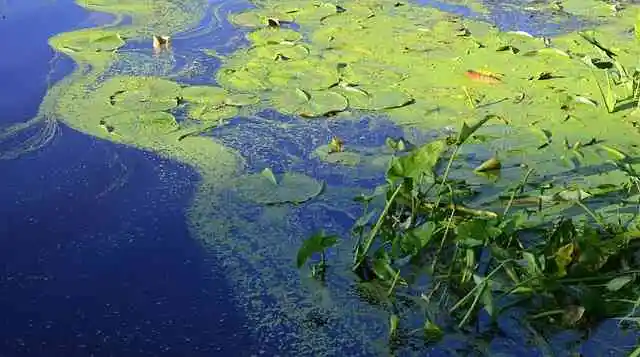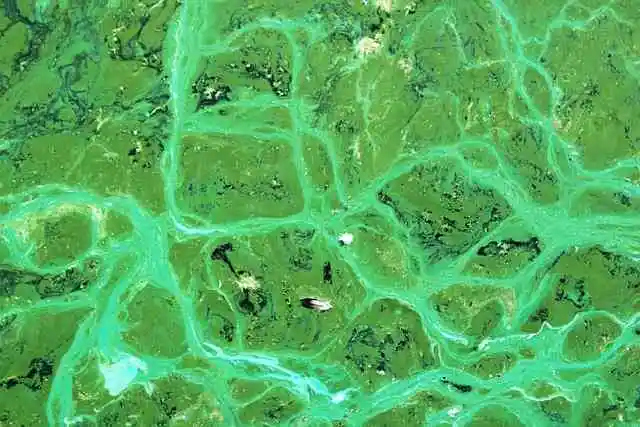Dogs bring joy and companionship to our lives. As responsible pet owners, it’s essential to keep them safe and healthy. One potential danger that dog owners should be aware of is blue-green algae, also known as cyanobacteria. This article will provide an in-depth understanding of blue algae. Its potential toxicity to dogs and the necessary precautions to protect our beloved furry friends.
What is blue-green algae?

Blue green algae, scientifically known as cyanobacteria, are microscopic organisms commonly found in bodies of water such as lakes, ponds, and rivers. They can multiply rapidly, forming a blue-green or greenish-brown layer on the water’s surface, resembling a thick mat or scum.
Where does blue-green algae grow?
It grow in warm, nutrient-rich environments. They can grow in both freshwater and saltwater bodies. It includes natural and artificial water sources like lakes, rivers, reservoirs, and even backyard ponds.
Factors that contribute to blue green algae growth
Several factors contribute to the growth of blue algae. It includes warm temperatures, stagnant water, excessive nutrients (such as nitrogen and phosphorus), and sunlight exposure. Human activities like agricultural runoff and pollution can also contribute to the proliferation of blue algae blooms.
Blue green algae toxicity in dogs

How does blue algae become toxic?
Certain species of blue algae produce toxins known as cyanotoxins, which can be harmful to dogs. These toxins are released when the blue algae bloom dies off or is disrupted, causing them to mix into the water. Dogs can be exposed to these toxins by drinking contaminated water or licking their fur after swimming in it.
Signs and symptoms of blue algae poisoning
Blue algae poisoning can have various symptoms, including:
- Vomiting
- Diarrhea
- Excessive drooling
- Difficulty breathing
- Seizures
- Weakness or lethargy
- Disorientation
If you notice any of these symptoms after your dog has been near water, especially water with blue-green or greenish-brown scum, seek veterinary attention immediately.
Immediate steps to take if exposure occurs
If you suspect your dog has been exposed to blue algae, take the following immediate steps:
- Remove your dog from the contaminated water.
- Rinse your dog’s fur thoroughly with clean water.
- Prevent your dog from licking its fur.
- Contact your veterinarian or an emergency animal hospital.
Preventing Blue-Green Algae Toxicity
Avoiding stagnant water sources
To reduce the risk of the algae exposure, it’s vital to avoid stagnant water sources with visible signs of blue-green or greenish-brown scum. Choose cleaner water bodies for your dog’s activities, such as flowing rivers or well-maintained lakes.
Recognizing signs of blue algae blooms
Educate yourself about the visual signs of blue algae blooms. Look for discolored water, floating scum, or foam-like residue on the water’s surface. Be cautious if you observe these signs and keep your dog away from such water sources.
Safe alternatives for water activities
Instead of exposing your dog to potentially contaminated water, consider safer alternatives for water activities. Look for dog-friendly beaches, swimming pools, or controlled water environments that are regularly monitored for water quality.
Treating Blue-Green Algae Poisoning
Veterinary care and diagnosis
If you suspect your dog has been exposed to blue-green algae toxins, it is vital to seek immediate veterinary care. The veterinarian will perform a thorough examination and may conduct blood tests, urinalysis, or other diagnostic procedures to assess the extent of the poisoning.
Treatment options for blue green algae toxicity
The treatment for toxicity depends on the severity of the symptoms and the toxins involved. It may include supportive care, such as intravenous fluids, medications to control seizures, and activated charcoal to bind the toxins. In severe cases, hospitalization and intensive care may be necessary.
Prognosis and long-term effects
The prognosis for dogs affected by blue algae toxicity varies depending on the individual case and the promptness of medical intervention. While some dogs may recover fully with timely treatment. Others may experience long-term complications or, in severe cases, even fatalities. The long-term effects can include liver damage, neurological problems, and organ failure.
Blue-Green Algae Safety Tips for Dog Owners
Keeping dogs away from potentially contaminated water
Prevention is key when it comes to protecting your dog from blue green algae toxicity. Always keep your dog away from water bodies that show signs of blue algae blooms. Remember that even small amounts of contaminated water can be dangerous.
Providing alternative drinking sources
Ensure your dog has access to clean and fresh drinking water at all times. Carry a water bottle and bowl during outdoor activities to offer your dog a safe drinking option.
Monitoring and observing dog behavior
Observe your dog’s behavior closely during water activities. Look out for any signs of distress, excessive licking, or unusual behavior that may indicate exposure to blue algae toxins. If you notice anything concerning, remove your dog from the water immediately.
Conclusion
Blue-green algae can pose a serious threat to our furry companions. Understanding the risks, recognizing the signs of blue algae blooms, and taking preventive measures are essential for keeping our dogs safe. Avoid potentially contaminated water sources by providing alternative drinking options. We can minimize the risk of blue algae toxicity by staying vigilant during water activities.
FAQs (Frequently Asked Questions)
Can blue green algae be harmful to humans as well?
Yes, blue algae can be harmful to humans if ingested or exposed in large quantities. It can cause skin irritation, gastrointestinal issues, or other health problems.
Are all types of blue algae toxic to dogs?
No, not all types of blue algae are toxic to dogs. However, it’s challenging to differentiate toxic from non-toxic species visually. It’s best to avoid all blue-green or greenish-brown water sources.
Can dogs get sick from swimming in water contaminated with blue algae but not drinking it?
Yes, dogs can get sick from swimming in water contaminated with blue algae. The toxins can enter their system through the skin or by licking their fur after exposure.
Is there a specific season when blue algae blooms are more common?
Blue algae blooms are more prevalent during warm weather, especially in late summer and early fall. However, they can occur throughout the year under favorable conditions.
Are there any long-term health effects on dogs that survive blue green algae poisoning?
Dogs that survive cyanobacteria poisoning may experience long-term health effects, such as liver damage, neurological issues, or organ failure. Regular veterinary follow-ups are important for monitoring their overall health.
What is blue-green algae caused from?
Blue green algae, also known as cyanobacteria, are caused by a combination of factors including warm temperatures, stagnant water, excessive nutrients (such as nitrogen and phosphorus), and sunlight exposure. Human activities like agricultural runoff and pollution can also contribute to the growth of blue green algae blooms.
What happens if you are exposed to blue-green algae?
Exposure to blue green algae can have various health effects depending on the level of toxins present. In humans, symptoms can range from skin irritation, gastrointestinal issues, respiratory problems, and even neurological effects if ingested or exposed to in large quantities. It is important to avoid contact with blue-green algae-contaminated water and seek medical attention if symptoms occur.
What is blue-green algae?
It is scientifically known as cyanobacteria, are a type of microscopic bacteria that can appear as blue-green or greenish-brown scum on the surface of bodies of water. They can release toxins called cyanotoxins, which can be harmful to humans, animals, and aquatic life.
Is blue-green algae safe to eat?
No, it should not be consumed. It can be toxic if ingested and can cause various health issues. It’s essential to avoid consuming or using water contaminated with cyanobacteria for cooking, drinking, or any other purposes.
Can you survive blue green algae?
Survival depends on the level of exposure and the specific cyanotoxins involved. While mild exposure to blue green algae may result in temporary symptoms, severe cases can be life-threatening. It’s crucial to avoid contact with or ingestion of blue-green algae contaminated water and seek immediate medical attention if exposure occurs. Prompt medical intervention improves the chances of survival and reduces potential long-term health effects.







Leave a Comment
You must be logged in to post a comment.